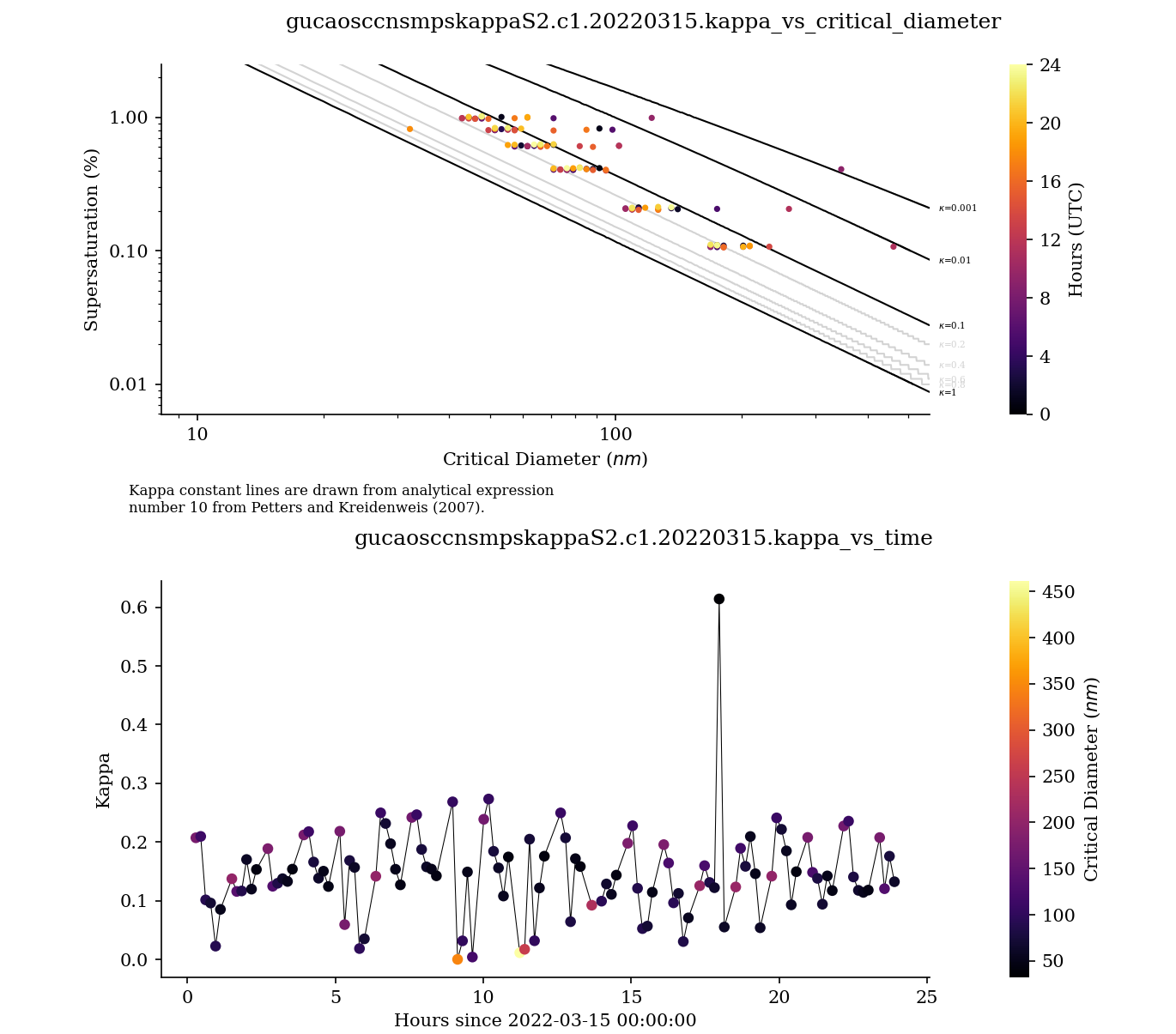New Aerosol Hygroscopicity Kappa Data Available
Published: 18 January 2024

The hygroscopicity parameter kappa quantifies a particle’s capacity to take up water from the environment and activate into a cloud droplet. Kappa is often used to model the cloud condensation nuclei (CCN) activity of atmospheric aerosols of different sizes and compositions, providing additional insight into the influence of aerosols on climate.
New data are available from a value-added product (VAP) that calculates kappa from CCN particle counter and scanning mobility particle sizer (SMPS) measurements collected by the Atmospheric Radiation Measurement (ARM) user facility.
Production data from the CCN Counter and SMPS Derived Hygroscopicity Parameter Kappa (CCNSMPSKAPPA) VAP are ready to use for the following ARM mobile deployments and fixed-location sites:
- the 2018–2019 Cloud, Aerosol, and Complex Terrain Interactions (CACTI) campaign near Córdoba, Argentina
- the 2019–2020 Cold-Air Outbreaks in the Marine Boundary Layer Experiment (COMBLE) in northern Norway
- the ongoing Eastern Pacific Cloud Aerosol Precipitation Experiment (EPCAPE) in La Jolla, California
- the 2016–2017 Layered Atlantic Smoke Interactions with Clouds (LASIC) campaign on Ascension Island in the South Atlantic Ocean
- the 2019–2020 Multidisciplinary Drifting Observatory for the Study of Arctic Climate (MOSAiC) expedition in the central Arctic
- the 2021–2023 Surface Atmosphere Integrated Field Laboratory (SAIL) campaign near Crested Butte, Colorado
- the Eastern North Atlantic (ENA) atmospheric observatory in the Azores, Portugal, from November 2022 to August 2023
- the Southern Great Plains (SGP) extended facility E13 near Lamont, Oklahoma, from April 2017 to August 2023.
In addition, scientists can now evaluate a new VAP that uses ARM CCN particle counter and ultra-high-sensitivity aerosol spectrometer (UHSAS) data to calculate kappa. The CCN Counter and UHSAS Derived Hygroscopicity Parameter Kappa (CCNUHSASKAPPA) VAP is available for the ENA from June 2016 to August 2023.
ARM’s CCN particle counter measures the fraction of ambient aerosols that can become liquid droplets at five supersaturations. These CCN data and co-located dry aerosol particle size measurements from the SMPS or UHSAS are used to calculate the critical diameter—the minimum particle diameter required to activate into a cloud droplet at each instrument supersaturation. For each critical diameter value, kappa is calculated using kappa-Köhler theory (Petters and Kreidenweis 2007).
The daily files of the CCNSMPSKAPPA and CCNUHSASKAPPA products provide the frequency distribution of kappa; kappa values within critical diameter-supersaturation field space; and time series of kappa, CCN concentrations, and supersaturation.
Both kappa products provide a means to quantify the hygroscopic properties of ambient aerosols. Scientists can use the VAPs to help improve the understanding of aerosol-cloud interactions and their representation in global earth system models.
Future work will involve expanding the CCNUHSASKAPPA VAP to sites without an SMPS.
To learn more about both kappa products, go to the CCN Counter Derived Hygroscopicity Parameter Kappa (CCNKAPPA) web page.
Access the CCNSMPSKAPPA and CCNUHSASKAPPA data in the ARM Data Center. (To download the data, first create an account.)
If you have questions or feedback to help improve these data, please contact science mentor Gourihar Kulkarni, ARM translator John Shilling, or VAP developer Maxwell Levin.
CCNSMPSKAPPA data can be referenced as doi:10.5439/1729907. CCNUHSASKAPPA data can be referenced as doi:10.5439/1984049.
Reference: Petters MD and SM Kreidenweis. 2007. “A single parameter representation of hygroscopic growth and cloud condensation nucleus activity.” Atmospheric Chemistry and Physics, 7, 1961-1971, https://doi.org/10.5194/acp-7-1961-2007.
Keep up with the Atmospheric Observer
Updates on ARM news, events, and opportunities delivered to your inbox
ARM User Profile
ARM welcomes users from all institutions and nations. A free ARM user account is needed to access ARM data.


















